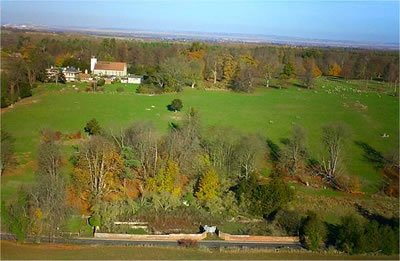 The gas yard was within the brick walls still standing at the bottom of the park by the Faversham Road. It stood near the site of an old manor house (presumably Whitemans), the foundations of which were still evident in the 1930's. Initially, coal gas was produced here; later, acetylene gas was stored in a Gasometer within the yard and piped up to Doddington Place. The pressure was regulated by a series of three pulleys, wheels, ropes and weights. The carbide was transported from Teynham in 1CWT steel kegs. When the steel barrels were opened - by chiselling off the tops - the carbide was removed for use in egg-sized lumps.
The gas yard was within the brick walls still standing at the bottom of the park by the Faversham Road. It stood near the site of an old manor house (presumably Whitemans), the foundations of which were still evident in the 1930's. Initially, coal gas was produced here; later, acetylene gas was stored in a Gasometer within the yard and piped up to Doddington Place. The pressure was regulated by a series of three pulleys, wheels, ropes and weights. The carbide was transported from Teynham in 1CWT steel kegs. When the steel barrels were opened - by chiselling off the tops - the carbide was removed for use in egg-sized lumps.
Mr J Wildash, a resident of the village, worked at the gas yard in 1936 at the age of 16/17 years. His grandfather, Mr Kite, was the game-keeper for Sir John Croft at Doddington Place. The role of the gas yard workers extended to keeping animals, such as poultry, pigs and sheep, to supply the 'big house' and for retail sale. The workmen were also responsible for the upkeep of paths, hedges, verges and stiles on the estate.
The production of gas at the yard ceased when the town gas was piped to the village, although it was occasionally used as a back-up pressure retainer when the town supply proved inadequate.
Later, the yard was used for the production of compost for the Mushroom Farm. Recently, it was transformed into a wood yard for a short period.
 The gas yard was within the brick walls still standing at the bottom of the park by the Faversham Road. It stood near the site of an old manor house (presumably Whitemans), the foundations of which were still evident in the 1930's. Initially, coal gas was produced here; later, acetylene gas was stored in a Gasometer within the yard and piped up to Doddington Place. The pressure was regulated by a series of three pulleys, wheels, ropes and weights. The carbide was transported from Teynham in 1CWT steel kegs. When the steel barrels were opened - by chiselling off the tops - the carbide was removed for use in egg-sized lumps.
The gas yard was within the brick walls still standing at the bottom of the park by the Faversham Road. It stood near the site of an old manor house (presumably Whitemans), the foundations of which were still evident in the 1930's. Initially, coal gas was produced here; later, acetylene gas was stored in a Gasometer within the yard and piped up to Doddington Place. The pressure was regulated by a series of three pulleys, wheels, ropes and weights. The carbide was transported from Teynham in 1CWT steel kegs. When the steel barrels were opened - by chiselling off the tops - the carbide was removed for use in egg-sized lumps.